Understanding Variability in Biomass Feedstocks and the Opportunities for Pre-Processing

Hannah Evans
Practice Manager, Bioenergy – Energy Systems Catapult

Bioenergy is a hugely valuable source of low-carbon renewable energy because it can be stored and used flexibly to produce heat, power, liquid and gaseous fuels. It has the potential to deliver negative emissions which the ETI anticipates are needed to deliver a low-carbon energy system cost-effectively.
The ETI has been commissioned to understand the variability in biomass feedstocks and the opportunities for pre-processing. Working with the Energy Systems Catapult (ESC), this insight suggests that producing bio-electricity or bio-hydrogen, in combination with CCS, could provide around 10% of projected UK energy demand.
The insight also explores how second generation crops are used to generate power and heat in the UK today but actually the market is nascent. The characteristics of these emerging feedstocks are different to commonly used wood chips and pellets and, if not managed properly, this can cause problems in boilers and other conversion technologies. To successfully integrate new feedstocks, either the end user must be able to accept greater physical and chemical feedstock variability, or feedstock production techniques and pre-processing must be used to make feedstocks more homogeneous.

Hannah Evans
Practice Manager, Bioenergy – Energy Systems Catapult